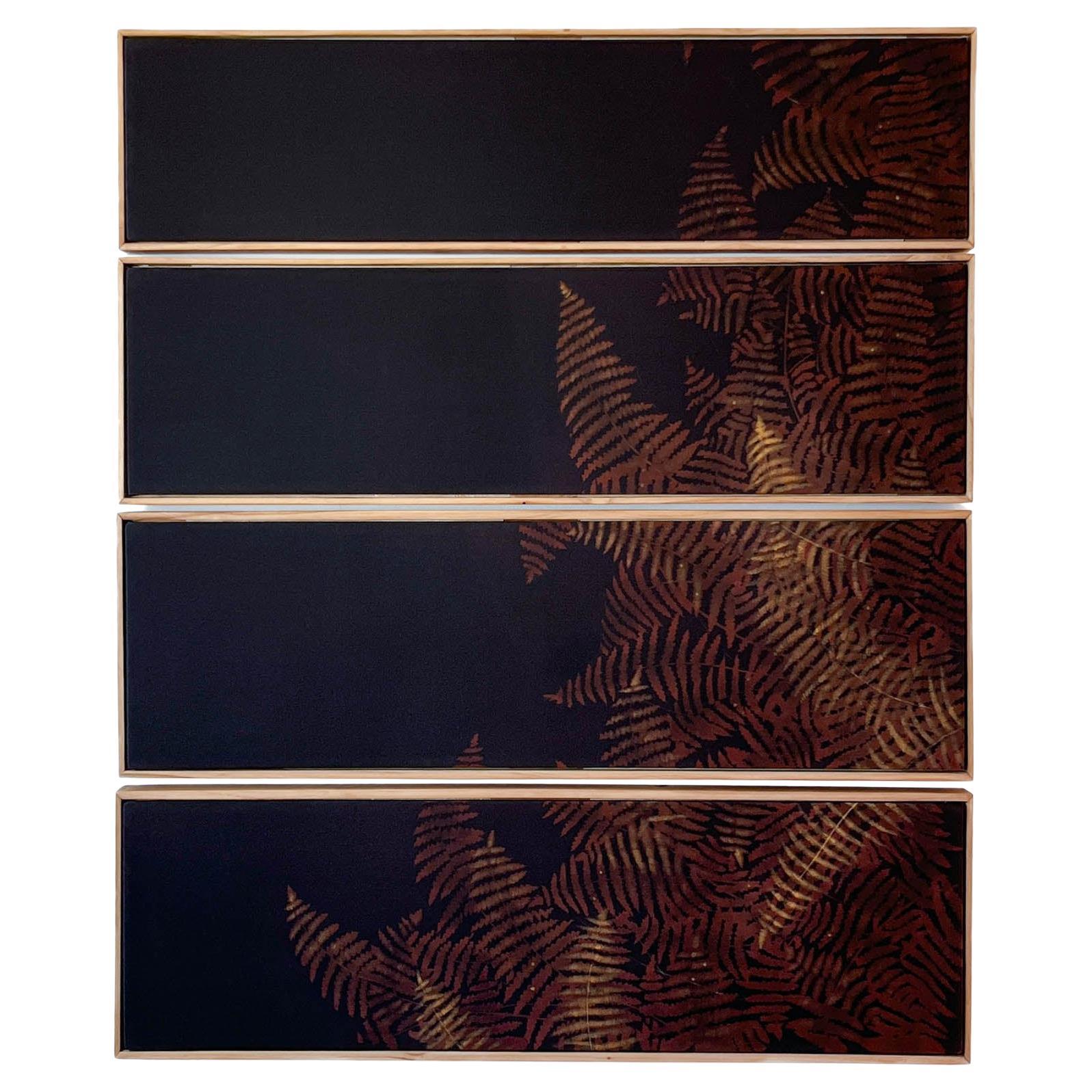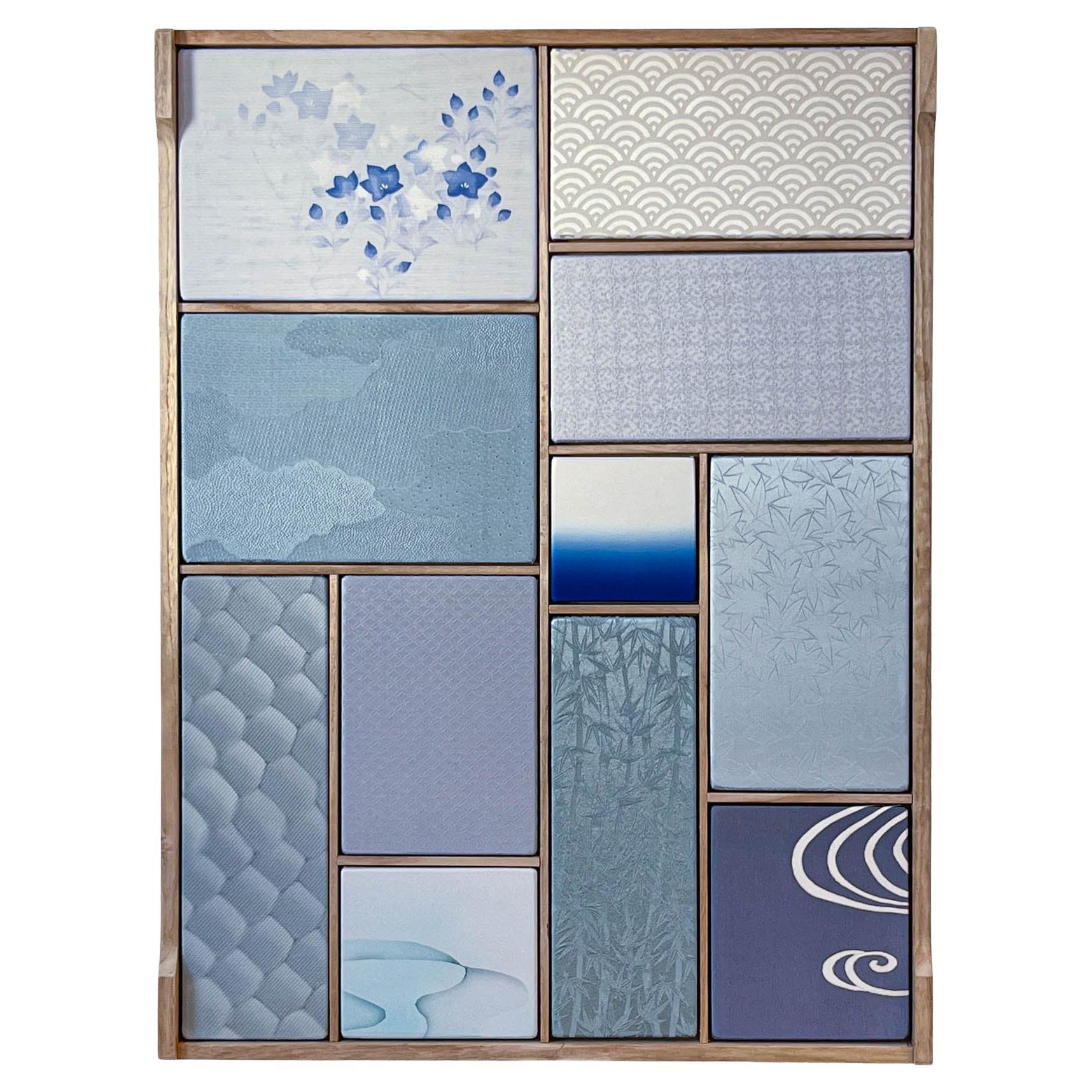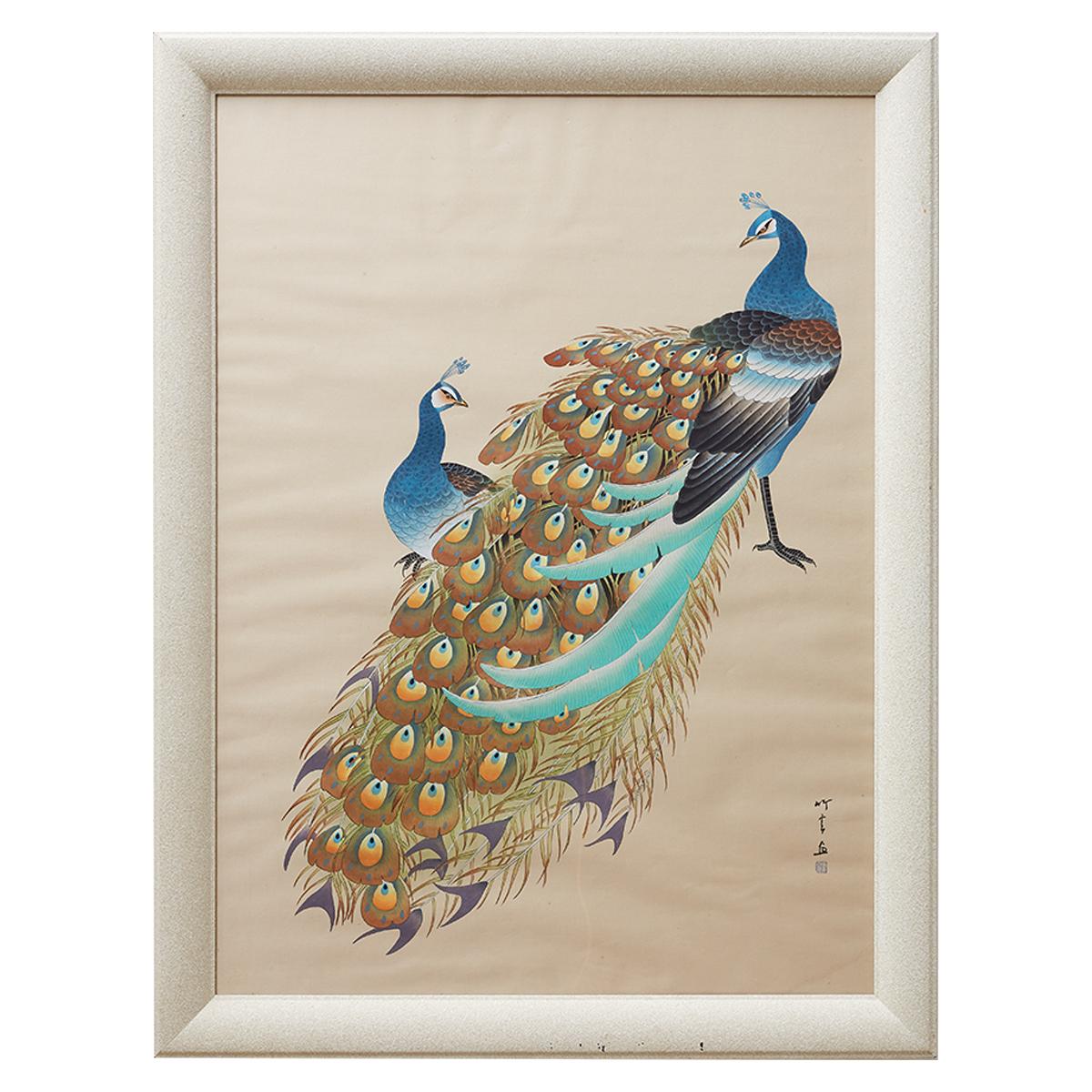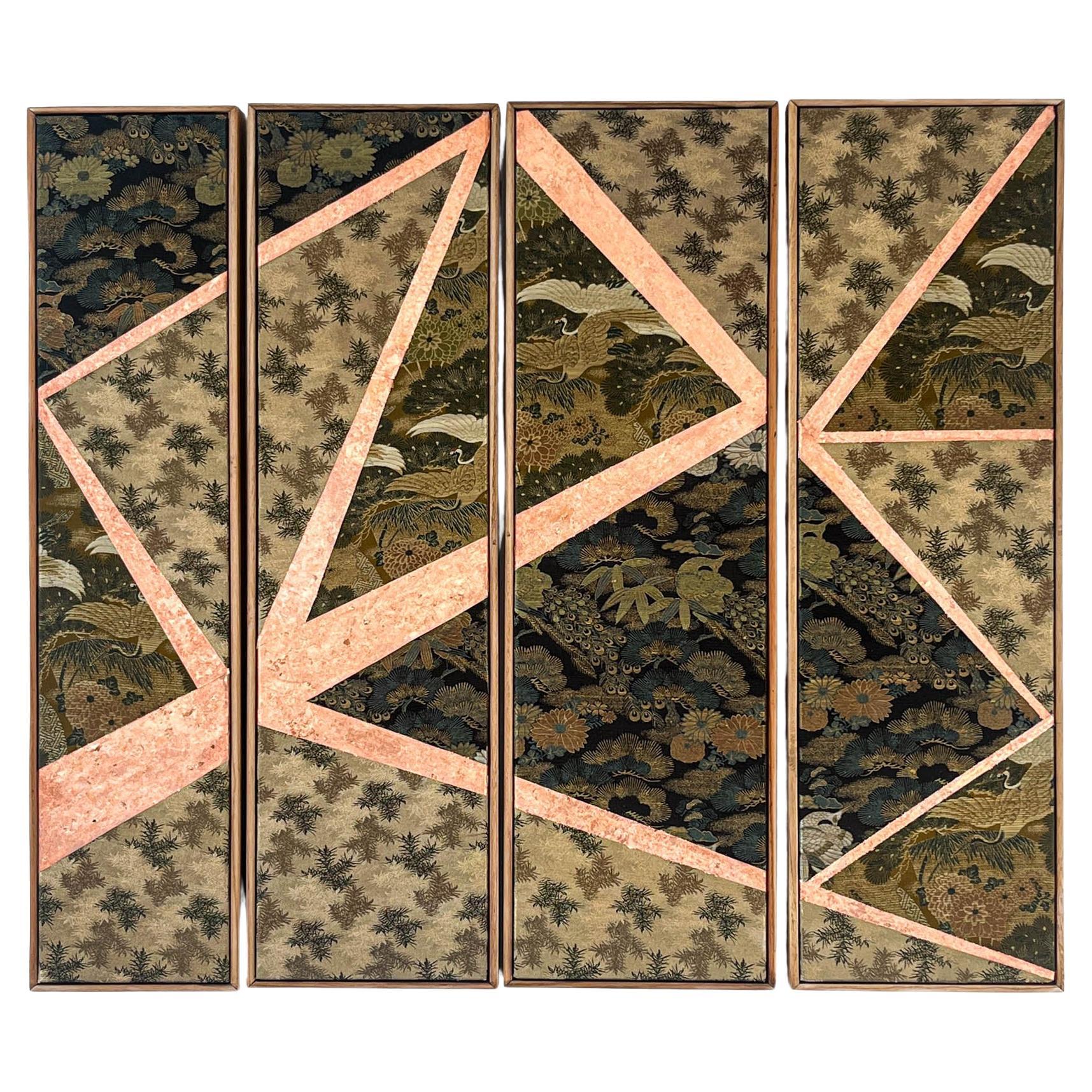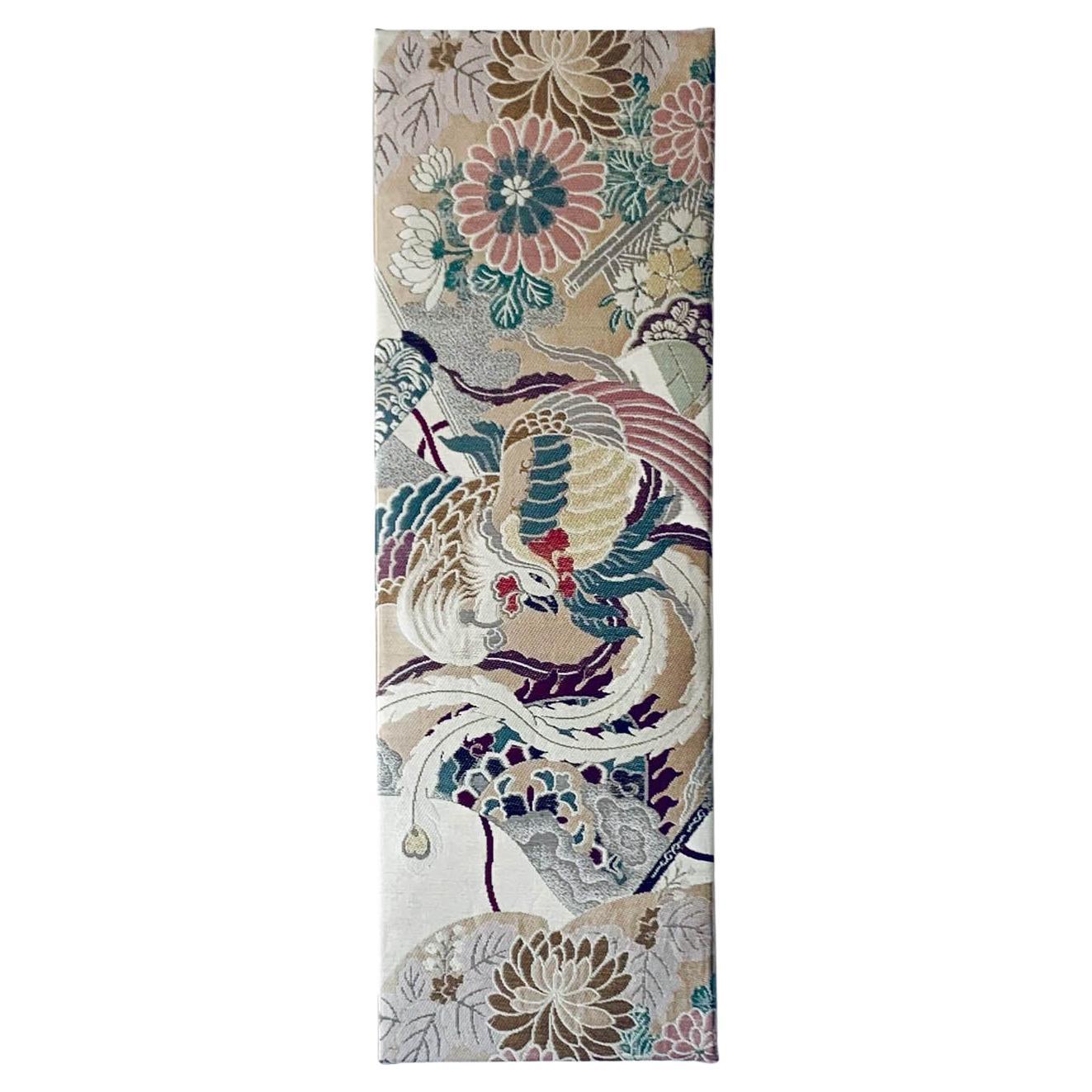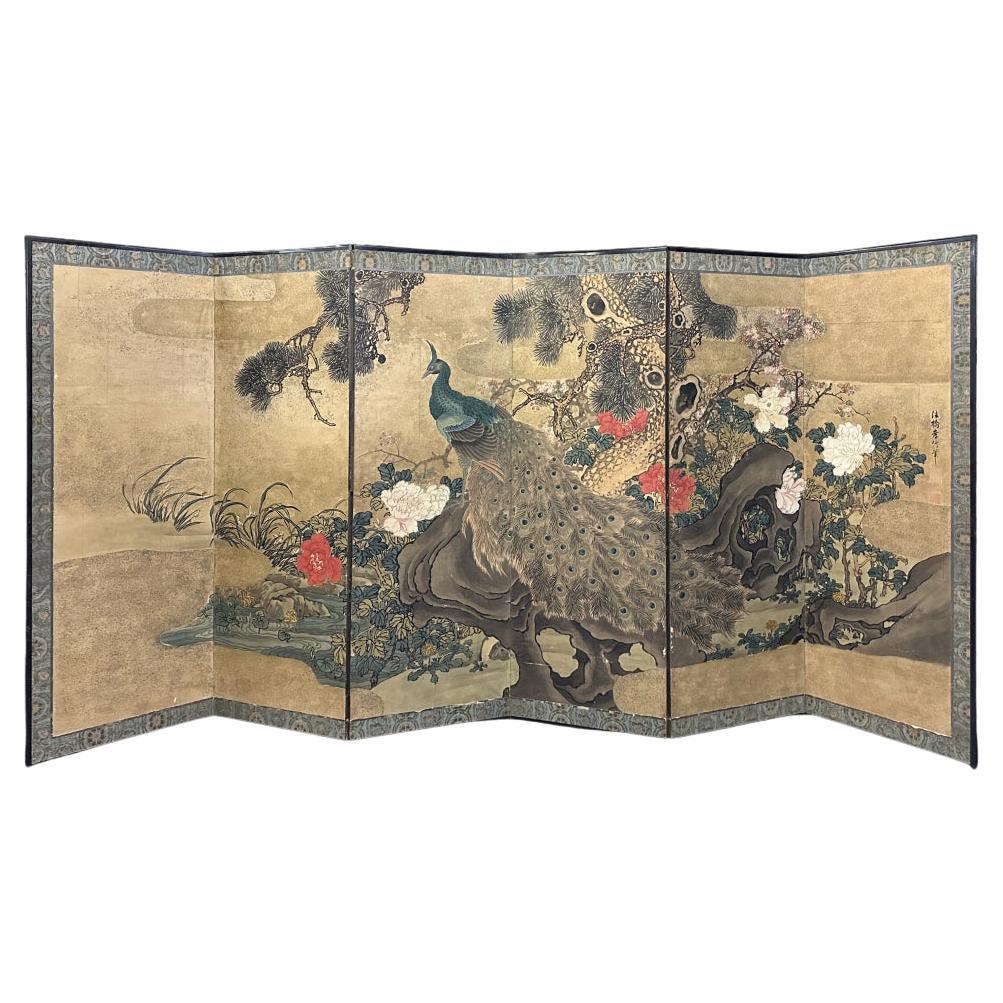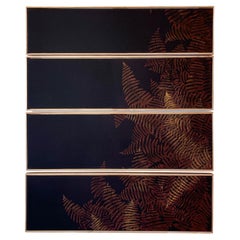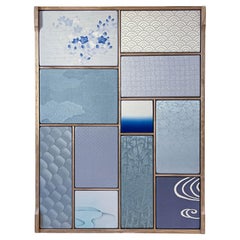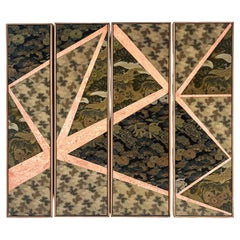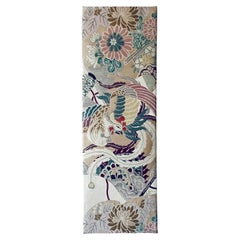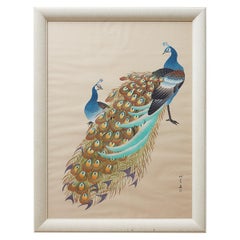Items Similar to Antique kimono textile art " Peacock Feathers ~Royalty~ " by ikasu Blue , Japan
Want more images or videos?
Request additional images or videos from the seller
1 of 21
Antique kimono textile art " Peacock Feathers ~Royalty~ " by ikasu Blue , Japan
$3,800
£2,923.21
€3,393.02
CA$5,358.91
A$6,002.88
CHF 3,152.93
MX$72,993.06
NOK 39,926.37
SEK 37,900.86
DKK 25,323.42
About the Item
This work uses an antique furisode (festive kind of kimono with long sleeves) with peacock feathers - a symbol of royalty and prosperity. Can be used both vertically and horizontally.
It is elegantly framed with paulownia wood originally used for kimono chest-of-drawers, and is filled with storytelling and sense of luxury.
I used pieces of kimono that could no longer be used as clothing and kiritansu chest-of-drawers that would normally be discarded to create the ultimate upcycled piece.
<< Period / Story >>
This artworks uses textile dated early 20th century, around 1920ies.
<< Explanation of colors and patterns >>
In Japanese traditional culture, peacock feathers carry several meanings and symbolisms, reflecting both aesthetic appreciation and deeper spiritual significance:
・Beauty and Elegance: Peacock feathers are renowned for their striking colors and intricate patterns. In Japanese culture, they are admired for their beauty and elegance, often used in traditional arts and crafts to adorn clothing, accessories, and decorative items. The vibrant hues and graceful lines of peacock feathers symbolize refinement and aesthetic appreciation.
・Protection and Warding Off Evil: In some Japanese beliefs, peacock feathers are considered talismans for protection against evil spirits and misfortune. It's believed that the radiant eyespots on peacock feathers have the power to ward off negative energy and bring good luck to the bearer. As such, peacock feathers are sometimes displayed in homes to safeguard against malevolent forces.
・Spiritual Significance: Peacock is associated with spiritual purity and enlightenment. The iridescent colors of the peacock's plumage symbolize the transformation of negative qualities into positive virtues on the path to enlightenment.
・Royal and Imperial Symbolism: Historically, the peacock has been associated with royalty and nobility in various cultures, including Japan. In Japanese imperial symbolism, the peacock is considered a symbol of regal beauty, power, and authority. Peacock feathers may be depicted in imperial crests, emblems, and ceremonial regalia as a symbol of the imperial family's prestige and lineage.
・Rebirth and Renewal: In Japanese folklore and mythology, the peacock is sometimes associated with themes of rebirth and renewal. Its ability to shed and regrow its feathers is seen as a metaphor for transformation and regeneration. Peacock feathers may be used in rituals or celebrations marking significant life transitions, such as weddings, coming-of-age ceremonies, or New Year's festivities, to symbolize new beginnings and opportunities.
Overall, peacock feathers in Japanese traditional culture symbolize beauty, protection, spirituality, and royalty. Their presence in various aspects of Japanese art, folklore, underscores their enduring significance as symbols of cultural richness and spiritual resonance.
<< Characteristics of the fabric >>
The fabric is decorated with hand-painted yuzen - a traditional Japanese painting technique, and golden and silver threads intricate embroidery called "kinkoma" - also unique Japanese technique.
- Creator:Kimono ikasu (Artist)
- Dimensions:Height: 35.44 in (90 cm)Width: 39.38 in (100 cm)Depth: 1.58 in (4 cm)
- Style:Japonisme (In the Style Of)
- Materials and Techniques:
- Place of Origin:
- Period:
- Date of Manufacture:around 1920ies
- Condition:
- Seller Location:Setagaya City, JP
- Reference Number:1stDibs: LU10079242702792
About the Seller
No Reviews Yet
Vetted Professional Seller
Every seller passes strict standards for authenticity and reliability
1stDibs seller since 2024
- ShippingRetrieving quote...Shipping from: Setagaya City, Japan
- Return Policy
Authenticity Guarantee
In the unlikely event there’s an issue with an item’s authenticity, contact us within 1 year for a full refund. DetailsMoney-Back Guarantee
If your item is not as described, is damaged in transit, or does not arrive, contact us within 7 days for a full refund. Details24-Hour Cancellation
You have a 24-hour grace period in which to reconsider your purchase, with no questions asked.Vetted Professional Sellers
Our world-class sellers must adhere to strict standards for service and quality, maintaining the integrity of our listings.Price-Match Guarantee
If you find that a seller listed the same item for a lower price elsewhere, we’ll match it.Trusted Global Delivery
Our best-in-class carrier network provides specialized shipping options worldwide, including custom delivery.More From This Seller
View AllVintage kimono textile art "Fern ~Connection to Nature~" by ikasu Black , Japan
By Kimono ikasu
Located in Setagaya City, JP
This work uses an antique tomesode (festive kind of kimono) with fern design to evoke feelings of tranquility, harmony, and appreciation for the beauty of the environment. Can be used both vertically and horizontally.
It is elegantly framed with paulownia wood originally used for kimono chest-of-drawers, and is filled with storytelling and sense of luxury.
I used pieces of kimono that could no longer be used as clothing and kiritansu chest-of-drawers that would normally be discarded to create the ultimate upcycled piece.
<< Explanation of colors and patterns >>
In Japanese traditional culture, ferns, particularly the Japanese painted fern (Athyrium niponicum), hold several meanings and symbolisms:
・Elegance and Beauty: Ferns are admired for their graceful, delicate appearance and intricate leaf patterns. In Japanese aesthetics, they are appreciated for their natural beauty and are often used in gardens, landscapes, and floral arrangements to add a sense of refinement and elegance.
・Resilience and Perseverance: Ferns are known for their ability to thrive in diverse environments, including shady forests, rocky cliffs, and damp soil. Their resilience in the face of challenging conditions is seen as a symbol of endurance and perseverance. In Japanese culture, ferns may represent the ability to overcome adversity and flourish despite obstacles.
・Connection to Nature and Tranquility: Ferns are native to forested areas and are often associated with the natural world. In Japanese traditional culture, they symbolize a deep connection to nature and the importance of maintaining harmony with the environment. The lush green foliage of ferns evokes feelings of tranquility and peacefulness, making them popular motifs in Zen gardens and traditional landscape paintings.
・Purity and Simplicity: Ferns are emblematic of simplicity and purity in Japanese aesthetics. Their unassuming beauty and understated elegance reflect the principles of wabi-sabi, an aesthetic worldview that values imperfection, impermanence, and simplicity. Ferns may be used in tea ceremonies, Ikebana (flower arranging), and other traditional arts to evoke a sense of tranquility and appreciation for life's fleeting moments.
Overall, ferns in Japanese traditional culture symbolize elegance, resilience, connection to nature, purity, and simplicity. Their presence in art, literature, and landscape design underscores their enduring significance as symbols of natural beauty and spiritual resonance.
<< Characteristics of the fabric >>
This vintage textile is hand-painted with a traditional Japanese technique called "yuzen".
<< About the frame >>
Kiritansu - chest-of-drawers for kimono, is traditionally made from paulownia wood, a uniquely Japanese material closely tied to the world of kimonos.
Paulownia wood is known as the lightest wood in Japan, prased for its natural luster, resistance to moisture, and resilience against cracking. Since ancient times, it has been used in crafting furniture, chests, and musical instruments.
During the Edo period, it became customary to store cherished kimonos in paulownia chests...
Category
Vintage 1960s Japanese Japonisme Paintings and Screens
Materials
Silk, Wood
Antique kimono textile art " Kobachi ~Marine Collection~ " by ikasu Blue, Japan
By Kimono ikasu
Located in Setagaya City, JP
This work is inspired by the blue color palette, and is framed in paulownia wood originally used for a kimono chest-of-drawers.
In this artwork, the aim was to capture the wide pale...
Category
Vintage 1920s Japanese Japonisme Paintings and Screens
Materials
Silk, Wood
Antique obi textile art " Pine forest ~ Longivety ~ " by ikasu Green , Japan
By Kimono ikasu
Located in Setagaya City, JP
<< Story behind the work >>
Obi fabric I used for this artwork is taken from three different over 100-years-old antique sashes, and is framed in wood taken from antique chest-of-dra...
Category
Early 20th Century Japanese Japonisme Paintings and Screens
Materials
Gold Leaf
Vintage obi textile art "From the Ashes ~Serendipity~" by ikasu Beige, Japan
By Kimono ikasu
Located in Setagaya City, JP
About This Canvas
This canvas has been upcycled from an early 20th-century maru-obi, featuring a subtle yet sophisticated depiction of the phoenix—a legendary symbol of peace and ren...
Category
Vintage 1910s Japanese Japonisme Decorative Art
Materials
Canvas, Silk
Vintage kimono textile art " Turquoise Forest ~Strength~ " by ikasu Blue, Japan
By Kimono ikasu
Located in Setagaya City, JP
Fabrics featuring iconic Japanese plants like chrysanthemum, maple, and bamboo were gathered from various long underwear and kimono pieces to create a set of canvases (diameter 30, 25 and 20cm) showcasing exquisite gradations.
The top canvas, in pristine white, originates from long under-kimono, while the middle and bottom canvases are skillfully upcycled from kimono fabrics.
<< Period / Story >>
The long under-kimono and kimono fabrics used in these canvases were originally crafted and worn during the late Showa period (1960-80ies).
<< Explanation and meaning of pattern and colors >>
The pattern on the top canvas features a chrysanthemum, an auspicious emblem symbolizing longevity. It is affectionately referred to as the "raccoon dog chrysanthemum" due to the large, overlapping petals resembling the fur of a muzina, a creature similar to a raccoon dog or badger. This motif is highly popular in various plant-inspired designs and frequently seen in Edo komon, katazome, and jimon textiles.
The top canvas naga-juban under-kimono, being entirely white and devoid of any additional dyes, suggests its use as formal wear. Its pristine white hue accentuates the silk's luster when exposed to light and highlights the beauty of the woven patterns.
The fabric used here is rinzu, a type of fabric thinner than crepe de chine, characterized by its soft, smooth texture and subtle sheen. This particular lintel distinguishes itself with the way its ground pattern emerges and also incorporates a woven chrysanthemum pattern.
The central canvas showcases a maple tree, symbolizing longevity, which changes its colors with the seasons, bringing joy and happiness to people's lives.
The bamboo featured on the lower canvas has been regarded as a symbol of good fortune since ancient times, given its straight and vigorous growth, along with the Chinese legend that a phoenix consumes its fruit. It embodies concepts such as "immortality," "longevity," and "strength" because it remains green even in winter. The hollow stem also signifies "innocence," suggesting that there are no hidden agendas.
All three canvases are adorned with ground patterns that, when viewed from a distance, appear as modern works of art, yet upon closer inspection, they reveal a distinct Japanese ambiance.
<< Characteristics of the fabric >>
All three canvases are made of fabrics with jimon. The unique and high level of Japanese weaving...
Category
Vintage 1970s Japanese Japonisme Paintings and Screens
Materials
Canvas, Silk
Antique kimono textile art "Kobachi ~ Green Collection ~" by ikasu Green, Japan
By Kimono ikasu
Located in Setagaya City, JP
This work is inspired by the green color palette, and is framed in paulownia wood originally used for a kimono chest-of-drawers.
In this artwork, the aim was to capture the wide pal...
Category
Vintage 1920s Japanese Japonisme Paintings and Screens
Materials
Silk, Wood
You May Also Like
Japanese Showa Period Peacocks Painted on Silk
Located in Rio Vista, CA
Colorful Japanese ink and color on silk Showa painting of a pair of peacocks. Vivid colors and beautiful details with a signature and seal on right side bottom. Framed in a midcentur...
Category
20th Century Japanese Showa Paintings and Screens
Materials
Silk, Plexiglass, Paper, Wood
$1,440 Sale Price
20% Off
Lavish 19th Century Maruyama School Peacock Screen
Located in Fukuoka, JP
Lavish 19th Century Maruyama School Peacock Screen
Period: 19th Century
Size: 360 x 173 cm (141.7 x 68.1 inches)
SKU: PF12
Behold the grandeur of the ...
Category
Antique 19th Century Japanese Edo Paintings and Screens
Materials
Wood, Paper
Japanese Antiques A hanging scroll of peacock painted by Kado for Tokonoma
Located in Niiza, JP
Color on silk, Scroll head: wood
Size: Image size: 680(W) x 1600(H) [mm]
Scroll mounting: 850(W) x 2300(H) [mm]
Box size: 100(W) x 100(H) x 940(D) [mm] 1.8kg
A very well-writte...
Category
Antique Mid-19th Century Japanese Paintings and Screens
Materials
Silk
Japanese Asian Large Meiji Period Silk Embroidery Peacock Bird Flower Tapestry
Located in Studio City, CA
A stunning Meiji Period (1868-1912) Japanese large framed embroidery/ tapestry featuring a pair of finely detailed birds - likely peacocks in a floral garden landscape. A truly magn...
Category
Antique 19th Century Japanese Meiji Tapestries
Materials
Silk, Glass, Wood
Spellbound Peacock Feather Armoire
By Koket
Located in Manassas, VA
There is a sense of reveal and conceal as KOKET takes a beautiful armoire in high gloss lacquer and adorns it in metal organic lace, revealing a mesmerizing hint of what lies beneath. The stunning interior opens to an antique mirror back with two glass shelves at top four drawers embellished with organic hardware finished to match the exterior.
Materials & Finishes:
Structure: Black Lacquer (High Gloss Finish)
Structure Sides: Black Lacquer (High Gloss Finish)
Door Front: Iridescent Peacock Feathers...
Category
2010s Portuguese Wardrobes and Armoires
Materials
Brass, Gold Leaf
$66,500 / item
Japanese Antique Hand Painted Lotus And Blue Waters Screen Vibrant Colors
Located in South Burlington, VT
From our recent Japanese Acquisitions- Hard to Find Lotus Flowers
A stunning Japanese Antique Hand Painted six panel byobu screen on silk executed with lovely lotus flowers and vib...
Category
Antique 19th Century Japanese Meiji Paintings and Screens
Materials
Gold Leaf
$1,320 Sale Price
20% Off
More Ways To Browse
Antique Feathers
Japanese Fabric Art
Japanese Kimono
Japanese Used Kimono
Antique Peacock
Peacock Feather
Peacock Blue Furniture
Upcycle Art
Arts And Crafts Screen
Antique Feather Painted Furniture
Framed Japanese Textiles
Japanese Embroidered
Gold Kimono
Blue Kimono
Antique Gold Silk Fabric
Asian Feather Art
Asian Painted Drawers
Antique Shed
